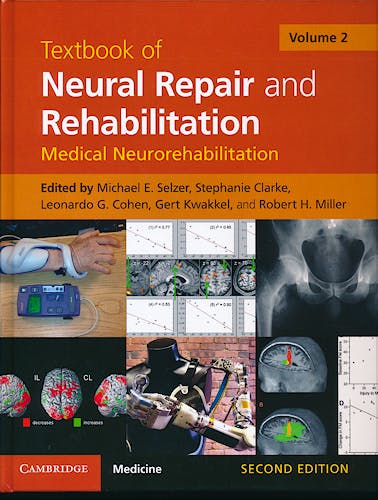

No hay productos en el carrito



Textbook of Neural Repair and Rehabilitation, Vol. 2: Medical Neurorehabilitation
Selzer, M. — Clarke, S. — Cohen, L. — Kwakkel, G. — Miller, R.
2ª Edición Abril 2014
Inglés
Tapa dura
709 pags
2248 gr
23 x 29 x 4 cm
ISBN 9781107011687
Editorial CAMBRIDGE
LIBRO IMPRESO
-5%
192,58 €182,95 €IVA incluido
185,17 €175,91 €IVA no incluido
Recíbelo en un plazo de
2 - 3 semanas
LIBRO ELECTRÓNICO
-5%
173,58 €164,90 €IVA incluido
166,90 €158,56 €IVA no incluido
Acceso On Line
Inmediato
Description
In two freestanding volumes, Textbook of Neural Repair and Rehabilitation provides comprehensive coverage of the science and practice of neurological rehabilitation. Revised throughout, bringing the book fully up to date, this volume, Medical Neurorehabilitation, can stand alone as a clinical handbook for neurorehabilitation. It covers the practical applications of the basic science principles presented in Volume 1, provides authoritative guidelines on the management of disabling symptoms, and describes comprehensive rehabilitation approaches for the major categories of disabling neurological disorders. New chapters have been added covering genetics in neurorehabilitation, the rehabilitation team and the economics of neurological rehabilitation, and brain stimulation, along with numerous others. Emphasizing the integration of basic and clinical knowledge, this book and its companion are edited and written by leading international authorities. Together they are an essential resource for neuroscientists and provide a foundation of the work of clinical neurorehabilitation professionals.
· Brings together latest research in rapidly developing field
· Written and edited by world-renowned experts in the field
· The first edition was a 'field-defining text'
Table of contents
Part I. Terminology of Neurorehabilitation – Outcome Measurement
and Diagnostic Technology:
1. Clinical trials in neurorehabilitation
2. Understanding the mechanisms underlying recovery after stroke
3. Genetics in neurorehabilitation
4. Outcomes measurement: basic principles and applications in stroke rehabilitation
5. Human voluntary motor control and dysfunction
6. Assessments, interventions, and outcome measures for walking
7. Clinical pathways
8. Electromyography in neurorehabilitation
9. Functional neuroimaging
Part II. Therapeutic Technology:
10. Evolving insights into motor learning and their implications for neurorehabilitation
11. Balance training
12. Functional electrical stimulation in neurorehabilitation
13. Peripheral nerve stimulation
14. Brain stimulation
15. Assistive devices
16. Wheelchair design and seating technology
17. Rehabilitation robotics, orthotics, and prosthetics for the upper extremity
18. Rehabilitation robotics, orthotics, and prosthetics: lower limb
19. Virtual reality applications in neurorehabilitation
20. Communication devices
21. Requirements for valid clinical trials
22. Spinal cord injury: mechanisms, cellular and molecular therapies, and human
translation
23. Motor neuroprosthetics
Part III. Organization of Rehabilitation Services:
24. Neurohabilitative interventions in the acute stage of diseases
25. The rehabilitation team and the economics of neurological rehabilitation
Part IV. Symptom-Specific Neurorehabilitation – Sensory and Motor Dysfunctions:
26. Chronic pain
27. Loss of somatic sensation
28. Management of deforming spastic paresis
29. Contemporary concepts in upper extremity rehabilitation
30. Gait disorders and rehabilitation
31. Balance function and dysfunction and the vestibular system
32. Deconditioning and energy expenditure
Part V. Vegetative and Autonomic Dysfunctions:
33. Acute neurorehabilitation for disorders of consciousness
34. Plasticity in the neural pathways for swallowing: role in rehabilitation
of dysphagia
35. Autonomic dysfunction
Part VI. Cognitive Rehabilitation:
36. Rehabilitation for aphasia
37. Apraxia
38. Unilateral neglect and anosognosia
39. Memory dysfunction
40. Neurorehabilitation of executive functions
41. Rehabilitation of visual field impairment
Part VII. Disease-Specific Neurorehabilitation Systems:
42. Rehabilitation of dementia
43. Traumatic brain injury
44. Neurorehabilitation in epilepsy
45. Parkinson's disease and other movement disorders
46. Predicting activities after stroke
47. Evidence-based benefit of rehabilitation after stroke
48. Rehabilitation in spinal cord injury
49. Multiple sclerosis
50. Neuromuscular rehabilitation: diseases of the motor neuron, peripheral nerve,
neuromuscular junction and the muscle
Index.
© 2025 Axón Librería S.L.
2.149.0